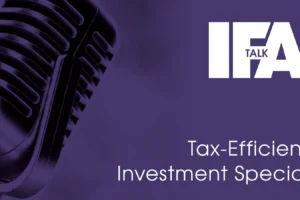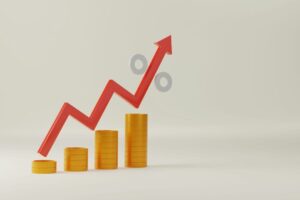In a world where markets seem to pivot on headlines and political rhetoric, staying ahead of the curve is no easy feat. But for Charles Younes, Deputy Chief Investment Officer at FE fundinfo, it’s all in a day’s work. IFA Magazine’s Senior Financial Journalist Jenny Hunter caught up with him to chat about where global markets are headed, how investor sentiment is evolving, and what financial advisers and investors should be thinking about in a time of high volatility and geopolitical tension.
With over a decade at FE fundinfo, Charles has built his career around dissecting risk, scrutinising macroeconomic shifts, and helping investors make sense of the chaos. He takes us on a whirlwind tour through everything from Chinese equities and US tech stocks to European fiscal policy, the future of the 60/40 portfolio, and why commodities might not be the silver bullet some investors expect.
From caution to cautious optimism
We kicked off with emerging markets, especially China—a space that’s been under the microscope for months. Despite ongoing macro concerns like property market woes and unresolved debt issues, Charles sees a shifting tide.
“What’s changed isn’t so much the fundamentals,” he explains, “but sentiment and liquidity.”
Thanks to stimulus packages and a more accommodating fiscal tone from the Chinese government, investor confidence is starting to thaw. “Six months ago, everyone wanted EM ex-China funds,” he says. “Now those calls have stopped. That tells you something.”
The Chinese government has made it clear that it wants to stabilise the markets. From welcoming back high-profile tech figures like Jack Ma to rolling out stimulus measures targeting various sectors, the leadership appears determined to rebuild trust. For investors, this means there’s a stronger policy signal on the direction of travel and a growing sense that the country is moving back to a more market-friendly footing.
Though the macro risks in China are far from resolved, the shift in tone—from restrictive to supportive—is enough for FE fundinfo to adjust their outlook. It’s a lesson in the importance of perception, not just performance. And when perception shifts in a market as large as China, it has ripple effects across the entire emerging markets block.
Trump, tariffs and turmoil
No discussion about markets would be complete without the mention of the T-word: Trump. With the former president back in the political spotlight, Charles admits there’s a degree of unavoidable uncertainty.
“Business investment doesn’t like unpredictability,” he notes. “And we’re expecting more of that in the US over the next four years.”
He argues that this uncertainty is likely to act as a drag on business investment and sentiment, even if the underlying fundamentals remain strong. While volatility is expected to be a recurring theme, especially as policy decisions become more unpredictable, Charles still sees resilience in US markets.
“The fundamentals are strong. We still expect the S&P 500 to return a high single-digit percentage over the next six to nine months.”
For long-term investors, that’s an important takeaway. While headlines may drive short-term sentiment, the strength and innovation of US companies continue to provide a solid base for returns.
The tech conundrum
Given the meteoric rise of tech stocks, the obvious question is: are we heading for a bubble?
“It’s less about a bubble,” Charles explains, “and more about managing risk.”
He points out that recent volatility wasn’t driven by macro data or geopolitical comments but by the tech sector itself. Value and cyclical funds—those overweight in industrials and materials—have performed better precisely because they’ve avoided the whiplash of tech.
“Tech is now your volatile part of the portfolio. We prefer being underweight right now.”
He doesn’t discount the strength of AI and innovation in the US but says the sector is simply too unpredictable in the short term. Events like abrupt regulation changes, high-profile CEO antics, and over-exuberant retail investor behaviour all feed into this.
“You’re really at the mercy of things you can’t predict, and that’s not a place we want to be overweight right now,” he adds.
This doesn’t mean tech is off the table completely. For long-term investors, exposure to key AI-driven trends still makes sense. But it’s about proportion and understanding where the risks lie.
Rates, risk and reality checks
When we pivot to interest rates, Charles doesn’t mince words: rates are likely to stay higher for longer than many investors were hoping.
“We’re more concerned about inflation than recession,” he says. “The data doesn’t scream recession.”
This view is backed up by hard data: consumer spending remains relatively strong, unemployment is low, and the Fed has little reason to panic. The bigger challenge? Stagflation—a nasty combination of slow growth and persistent inflation.
“Stagflation is a nightmare for central banks,” Charles explains. “And it forces tough decisions, especially when politics come into play.”
As for fixed income, Charles and his team have stayed underweight on duration. With cash yielding 4.5% and bond markets facing potential stagflation, he questions the value of locking into long-term positions right now.
“Unless you believe 2026 will see a significant slowdown, it’s hard to justify the risk,” he says. “We’d rather take equity risk over duration risk.”
European equities: the comeback kid?
Turning our attention to Europe, Charles is notably upbeat. After a long period of underperformance, European markets are finally showing signs of life.
“We’re seeing an improvement in macro conditions and sentiment,” he says.
The big game-changer? Germany relaxing its long-held fiscal discipline. With stimulus pouring into defence and infrastructure, domestic companies are benefiting.
“We’re seeing a rotation out of US equities and into Europe. There’s also a valuation gap—European companies are trading at discounts compared to their US peers.”
Charles also highlights the impact of broader policy shifts. The European Central Bank, while more cautious than the Fed, has shown signs of supporting growth initiatives. And investors are taking notice. “You’ve got consumer companies, industrials, and even defence stocks trading at compelling valuations,” he notes.
For now, Europe looks to be regaining investor favour. And with macro headwinds easing, the outlook is starting to feel less gloomy.
Gold, gas and the diversification dilemma
So where do commodities fit into all this?
“They’re not currently part of our strategic allocation,” Charles says. But he acknowledges that they’re increasingly appealing in an inflationary world.
“If you’re worried about inflation, commodities like gold or energy can offer more than just stability.”
Still, he favours liquid hedge funds as portfolio diversifiers. “You’ve got these global macro managers who thrive on the desynchronisation we’re seeing across economies. That’s a dream scenario for them.”
Commodities might have a place, especially for investors nervous about policy missteps or inflation spikes. But for now, Charles prefers more nimble, alternative strategies that can move quickly with changing macro conditions.
Geopolitical risk and the long game
Of course, no market outlook would be complete without touching on geopolitics. From conflicts in Ukraine to trade tensions and the broader implications of deglobalisation, global instability is a persistent concern.
Rather than trying to game short-term winners, Charles sees these events as strategic triggers.
“It’s pushing us to rethink the strategic asset allocation,” he says. “We’re moving into a high inflation world for the long term, and that needs to be reflected in our models.”
He also notes that sectors like value and cyclicals tend to do well in such environments, offering a practical path for portfolio construction. Defence, infrastructure, and resource-based companies could all see tailwinds as countries prioritise security and self-sufficiency.
Eyes wide open
If there’s one thing Charles Younes makes clear, it’s that investing today requires a broader lens and a more nuanced understanding of global events. It’s no longer just about picking a fund or favouring a region. It’s about balancing risk, sentiment, and valuation in an ever-changing world.
From the US to Europe, China to commodities, the key is staying nimble, informed, and open to rethinking old assumptions. Whether you’re a DIY investor or a seasoned adviser, Charles’ insights offer a practical and grounded roadmap for navigating whatever the markets throw at us next.
And if you’re still trying to do it all in-house? Maybe it’s time to take a leaf out of Charles’ book: build the frameworks, lean on the data, and above all, stay flexible.
About Charles Younes
Charles Younes is Deputy Chief Investment Officer at FE fundinfo. His responsibilities extend across the production of analysis and research documents, managing relationships with fund managers, and overseeing the continued investment strategy of FE fundinfo’s recommended funds list and model portfolios.
Prior to joining FE fundinfo, Charles was a Hedge Fund Analyst at Amundi Alternative Investments for two years, mainly covering long/short equities and event-driven strategies. Charles started his career in Paris in 2008 with AMLab, a subsidiary of OFI AM and La Banque Postale.
















